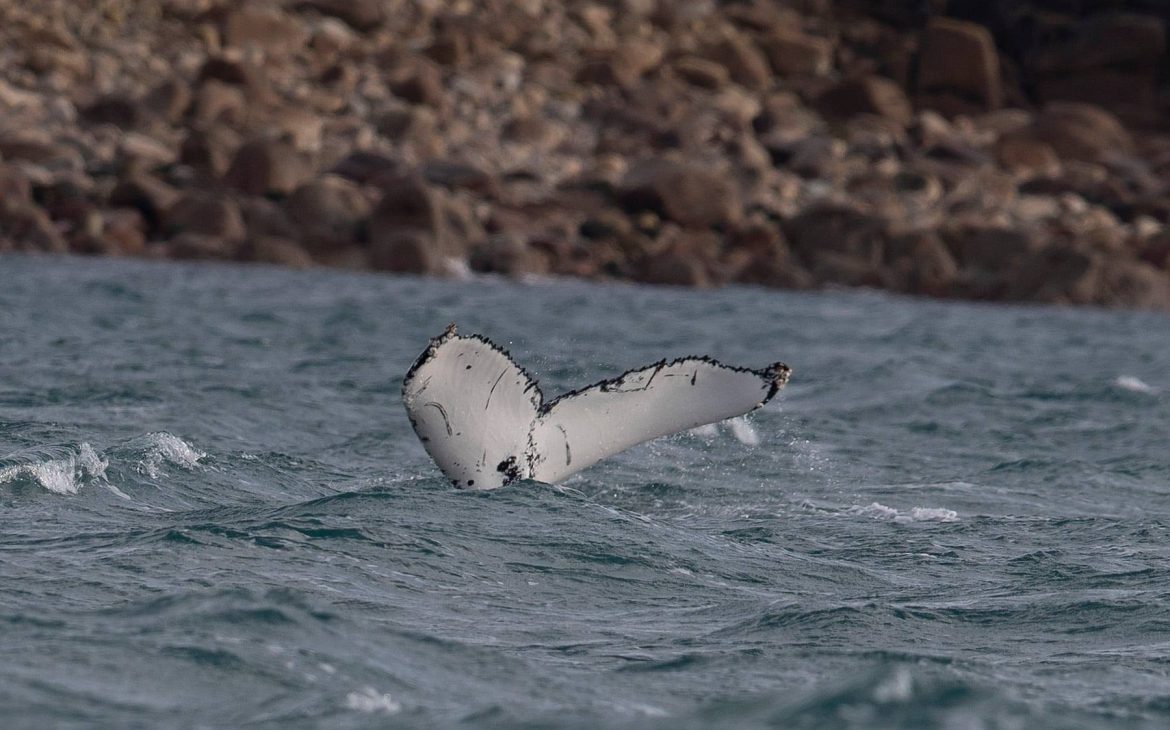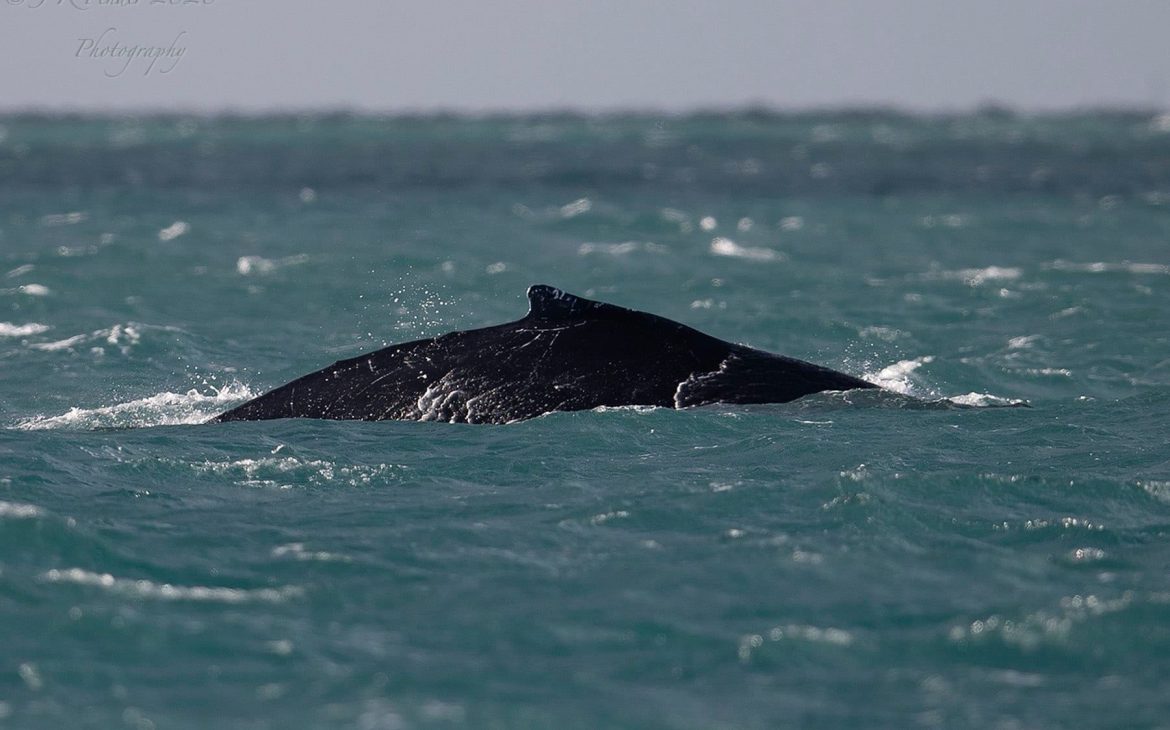Reviewing the whales around Scilly in winter 2020-21, by Will Wagstaff
Over the years, whale sightings in Scillonian waters have been few and far between. The Minke Whale has been the most regularly noted but even then a rare sight. Long-finned Pilot Whales were seen occasionally but have become even scarcer in recent years. Various dolphin species have been the mainstay of any cetacean records, with most whale sightings from pelagic trips a few miles offshore.
That was until winter 2020-21, when we were treated to multiple and regular sightings of two species of whale. Fin Whales had previously been seen south and east of the islands, including one from Deep Point in January 2020, but little did we know that three records to the south of St Agnes and then Peninnis Head on 23rd November would start a winter of sightings for this species.
The sighting of a Humpback from a pelagic on 31st August, followed by two from St Martin’s on 6th December, were the most records of this species we had noted from Scilly in living memory. Then, to see a message on our Whatsapp groups on Christmas Eve saying there was a Humpback Whale between St Mary’s and Samson was a surreal moment. This individual returned on 25th and 26th and again on 31st-1st when at least two more Humpbacks were noted south of St Mary’s with two Fin Whales slightly to the east. Large numbers of Common Dolphins were often associated with them, along with huge numbers of Kittiwakes and Gannets.
The lone Humpback came between St Mary’s, Samson and St Agnes throughout January and February, with occasional gaps until it was last seen along the south side of St Mary’s on 27th February. It preferred coming into the ‘Roads’ in late afternoon, although it was seen at other times, including occasionally breaching. The sightings of Fin Whales were more sporadic but were recorded on several dates from the south side of St Mary’s or east of St Martin’s with at least one sighting to the west. Often two or three individuals were noted, usually at least a mile offshore, occasionally a little nearer. Sightings became less frequent in late February, but at least one was noted in 3rd week of March. This prompted the republication of a photo of an individual seen a mile south of St Mary’s on 28th August 2008. Thanks to photo-matching software, this was identified as the same whale seen in August 2012 off the coast of Franz Josef Land in the Arctic Ocean.
Large numbers of dolphins and seabirds were seen around the same time, suggesting that food was the main draw to the area, with large shoals of small fish (sprats, sardines and anchovies) noted.
Fin Whales are widely distributed in cool temperate-to-polar waters around the world. Some populations appear to migrate from the rich feeding grounds around the poles to warmer waters to breed but do not follow a steady pattern and as such can appear in any area and stay for some time. This behaviour has been seen in the warmer waters of the Gulf Stream. Higher numbers have been noted around the edges of the continental shelf but, as we have seen, they will follow food into shallower waters. The increase in Tuna and dolphin sightings around the islands is probably also associated with an increase in food. Assuming this trend continues, there is a good chance we will get more sightings of this ‘greyhound of the sea’ (nicknamed due to their ability to reach speeds of 22mph in short bursts).
Humpback Whales are strongly migratory moving from polar feeding grounds to warmer waters to breed. They are found in all depths, crossing the deeper waters on migration but feeding more on continental shelf and coastal waters. In the North Atlantic most are found in Norway, Iceland and Greenland before heading to the Caribbean to breed during the northern winter, with smaller numbers utilising the Cape Verde Islands vicinity. There is also the suggestion of a third, as yet unknown breeding ground. Some will stay north during the winter, whether they are late migrants or truly overwintering is being studied, and this may be the origin of those seen around Scilly. The long-staying animal was not very large, so may not have been fully grown and thus part of the breeding cycle.
The North Atlantic Humpback Whale Catalogue (NAHWC) has recently received more submissions from Ireland and Scotland, but still very few from English waters. The NAHWC now includes over 10,000 individual humpback whales sighted from as early as 1958. We would be interested in comparing any old or new fluke photos from the Isles of Scilly to track humpbacks across the North Atlantic. Whales are assigned unique numbers and we track any names assigned to them, so the whale seen in 2008 and then in the Arctic in 2012 is catalogued as #na04711.
Images from the NAHWC helped develop the automatic matching algorithms used on HappyWhale (HW) but not all 10,000+ whales are publicly available; many images were submitted privately by research groups and cannot be shared. Images submitted to HW do not currently go to the NAHWC automatically, but people are welcome to submit images to both. The NAHWC only includes fluke photos (not dorsal fins) of non-calf humpbacks and is quality controlled, using a combination of HW’s automated matching and a visual comparison by an experienced researcher. We help put people in touch when humpback re-sightings are found to contribute to our knowledge about movements and populations, which inform international conservation and management efforts. All that is needed is a fluke photo, sighting data, location (descriptive or GPS coordinates), and photographer contact information.
I never thought I’d say this of Scilly, but it was amazing to see so many people out on the coast looking for whales. Will the whales return in future? That’s the million-dollar question. Let’s hope so!


Links:
North Atlantic Humpback Whale Catalogue https://www.coa.edu/allied-whale/
HappyWhale https://happywhale.com/home